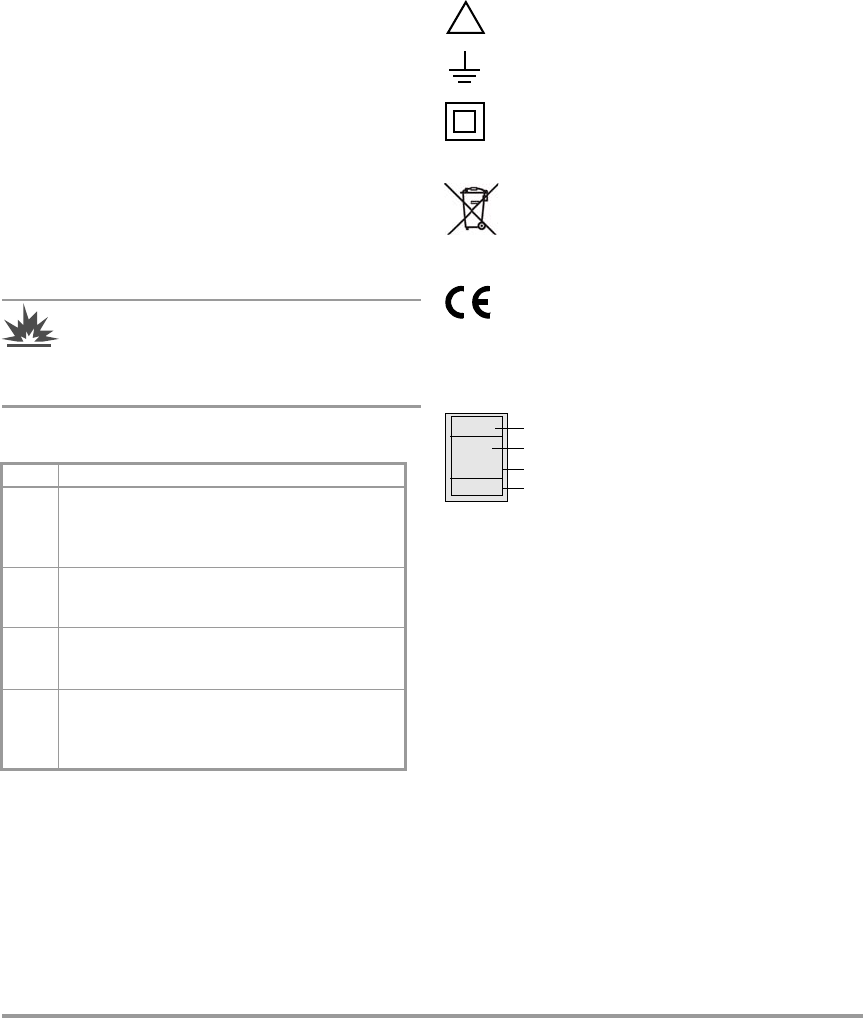User manual
Table Of Contents
- 1 Safety Features and Precautions
- 2 Initial Start-Up
- 3 Selecting Measuring Functions and Measuring Ranges
- 4 LCD
- 5 Measured Value Memory “HOLD”
- 6 Saving Minimum or Maximum Values “MIN/MAX” Hold
- 7 Voltage Measurement
- 8 Current Measurement
- 9 Resistance Measurement
- 10 Continuity and Diode Testing
- 11 Temperature Measurement
- 12 Characteristic Values
- 13 Maintenance
- 14 Recalibration
- 15 Accessories
- 16 Repair and Replacement Parts Service, Calibration Center* and Rental Instrument Service
- 17 Manufacturer‘s Guarantee
- 18 Product Support

4 GMC-I Messtechnik GmbH
• Make certain that the measurement cables are in flawless
condition, e.g. no damage to insulation, no interruptions
in cables or plugs etc.
• No measurements may be made with this instrument in
electrical circuits with corona discharge (high-voltage).
• Special care is required when measurements are made in
HF electrical circuits. Dangerous pulsating voltages may
be present.
• Measurements under moist ambient conditions are not
permitted.
• Be absolutely certain that the measuring ranges are not
overloaded beyond their allowable capacities. Limit values
can be found in the “Measuring Ranges” table in chapter
12 “Characteristic Values”.
• All current measuring ranges are protected with fuses.
Maximum allowable voltage for the measuring current
circuit is 600 V in all “mA” and “A” ranges.
Warning!
The instrument may not be operated in explosive
atmospheres, or connected to intrinsically safe
electrical circuits.
Measuring Categories and their Meaning per IEC 61010-1
The measurement category and the relevant maximum rated
voltage (e. g. 600 V CAT III) which are shown on the
instrument casing apply to your measuring instrument.
Meanings of symbols on the instrument:
Warning concerning a source of danger
(attention: observe documentation)
Earth terminal
Continuous, doubled or reinforced
insulation
This device may not be disposed of with the
trash. Further information regarding the WEEE
mark can be accessed on the Internet at
www.gossenmetrawatt.com by entering the
search term ’WEEE’.
Indicates EC conformity
CAT III
Maximum allowable voltage
between the
connector jacks and earth is
600 V, category III
.
DAkkS Calibration Upon Request
See also chapter 14 “Recalibration”.
Repair, Parts Replacement and Balancing
When the instrument is opened, voltage conducting parts
may be exposed. The instrument must be disconnected from
the measuring circuit before the performance of repairs, the
replacement of parts or balancing. If balancing, maintenance
or repair of a live open instrument is required, this may only
be carried out by trained personnel who are familiar with the
dangers involved.
Defects and Extraordinary Strains
If it may be assumed that the instrument can no longer be
operated safely, it must be removed from service and
secured against unintentional use.
Safe operation can no longer be relied upon:
• If the device demonstrates visible damage
• If the instrument no longer functions
• After lengthy periods of storage under unfavorable
conditions (e.g. humidity, dust, temperature), see
ambient conditions on page 15
CAT Definition
I
Measurements in electrical circuits not directly
connected to the mains system:
e. g. power systems in motor vehicles or
aeroplanes, batteries ...
II
Measurements in electrical circuits directly
connected to the low-voltage system:
via plug, e.g. in households, offices, laboratories ...
III
Measurements in facility installations:
stationary consumers, distributor connections,
devices attached to a distributor
IV
Measurements at the source of low-voltage
installations:
Meters, main terminal, primary overcurrent
protection devices
!
XY123
2012-06
D-K
15080-01-01
Consecutive number
Registration number
Date of calibration (year – month)
Deutsche Akkreditierungsstelle GmbH – calibration lab










